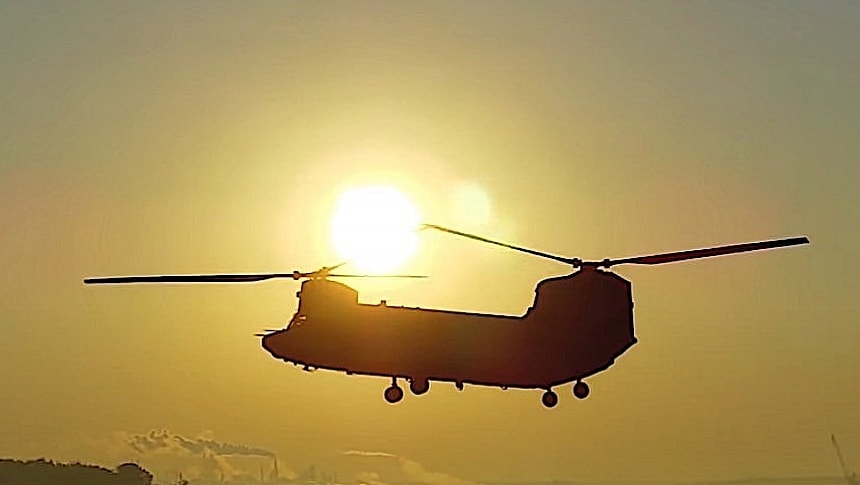Helicopters are, by design, kind of quirky aircraft, but on the scale of strangeness there's nothing more so than the CH-47 Chinook, the so-called king of pinnacle landings. And not even the most recent upgrade package for it doesn't make it less so.
The Chinook, like pretty much all other military aircraft in operation, is quite an old platform. The thing had its first flight back in 1961 and entered military service just one year later. It rapidly became a favorite workhorse for the U.S. Army.
That's because the helicopter's configuration, a twin-engine tandem rotor, allows it to lift as much as 26,000 lbs (11,793 kg) of cargo. The engines that power it are of the Lycoming (now Honeywell) T55 turboshaft variety, each of them capable of developing 4,732 shaft horsepower.
The above numbers apply to the standard variant of the helo because, believe it or not, the platform wasn't modernized too much over the years. But that will change as not long ago the U.S. Army tapped the aircraft's maker, Boeing, with improving some of the Chinook's capabilities.
The aerospace company calls the series of upgrades Block II, and they are meant for the CH-47F Chinook with the goal of making these platforms capable to lift more and fly farther than before.
First on the list are the changes Block II brings to the aircraft's engines. Although they remain the same T55s as before, the upgrades should allow the helicopter to lift a total of 27,700 pounds (12,565 kg), while at the same time increasing its max gross weight by 4,000 pounds (1,814 kg).
The performance numbers for the Block II as provided by Boeing show the Chinook in this configuration will be capable of flying at speeds of 188 mph (302 kph) and for as much as 190 miles (306 km).
Block II also brings undisclosed improvements to the airframe to make it more resistant and to the fuel system to reduce cost, while a new rotor system is specified in a bid to minimize unscheduled maintenance.
Boeing has been at it working on getting the Chinook to Block II configuration for a while now, with the first three helicopters entering an active modernization stage back in 2018.
This June, six years after the fact, Boeing said in finally managed to deliver the first Block II CH-47F Chinook to the U.S. Army. That's only the tip of the iceberg, as the military branch needs a total of 465 such aircraft brought up to the new specs.
Boeing does not say how long it will take for work to be completed, but one key aspect of the Block II package is that it "enables future technology upgrades," so no rush there.
That's because the helicopter's configuration, a twin-engine tandem rotor, allows it to lift as much as 26,000 lbs (11,793 kg) of cargo. The engines that power it are of the Lycoming (now Honeywell) T55 turboshaft variety, each of them capable of developing 4,732 shaft horsepower.
The above numbers apply to the standard variant of the helo because, believe it or not, the platform wasn't modernized too much over the years. But that will change as not long ago the U.S. Army tapped the aircraft's maker, Boeing, with improving some of the Chinook's capabilities.
The aerospace company calls the series of upgrades Block II, and they are meant for the CH-47F Chinook with the goal of making these platforms capable to lift more and fly farther than before.
First on the list are the changes Block II brings to the aircraft's engines. Although they remain the same T55s as before, the upgrades should allow the helicopter to lift a total of 27,700 pounds (12,565 kg), while at the same time increasing its max gross weight by 4,000 pounds (1,814 kg).
The performance numbers for the Block II as provided by Boeing show the Chinook in this configuration will be capable of flying at speeds of 188 mph (302 kph) and for as much as 190 miles (306 km).
Block II also brings undisclosed improvements to the airframe to make it more resistant and to the fuel system to reduce cost, while a new rotor system is specified in a bid to minimize unscheduled maintenance.
Boeing has been at it working on getting the Chinook to Block II configuration for a while now, with the first three helicopters entering an active modernization stage back in 2018.
This June, six years after the fact, Boeing said in finally managed to deliver the first Block II CH-47F Chinook to the U.S. Army. That's only the tip of the iceberg, as the military branch needs a total of 465 such aircraft brought up to the new specs.
Boeing does not say how long it will take for work to be completed, but one key aspect of the Block II package is that it "enables future technology upgrades," so no rush there.


























